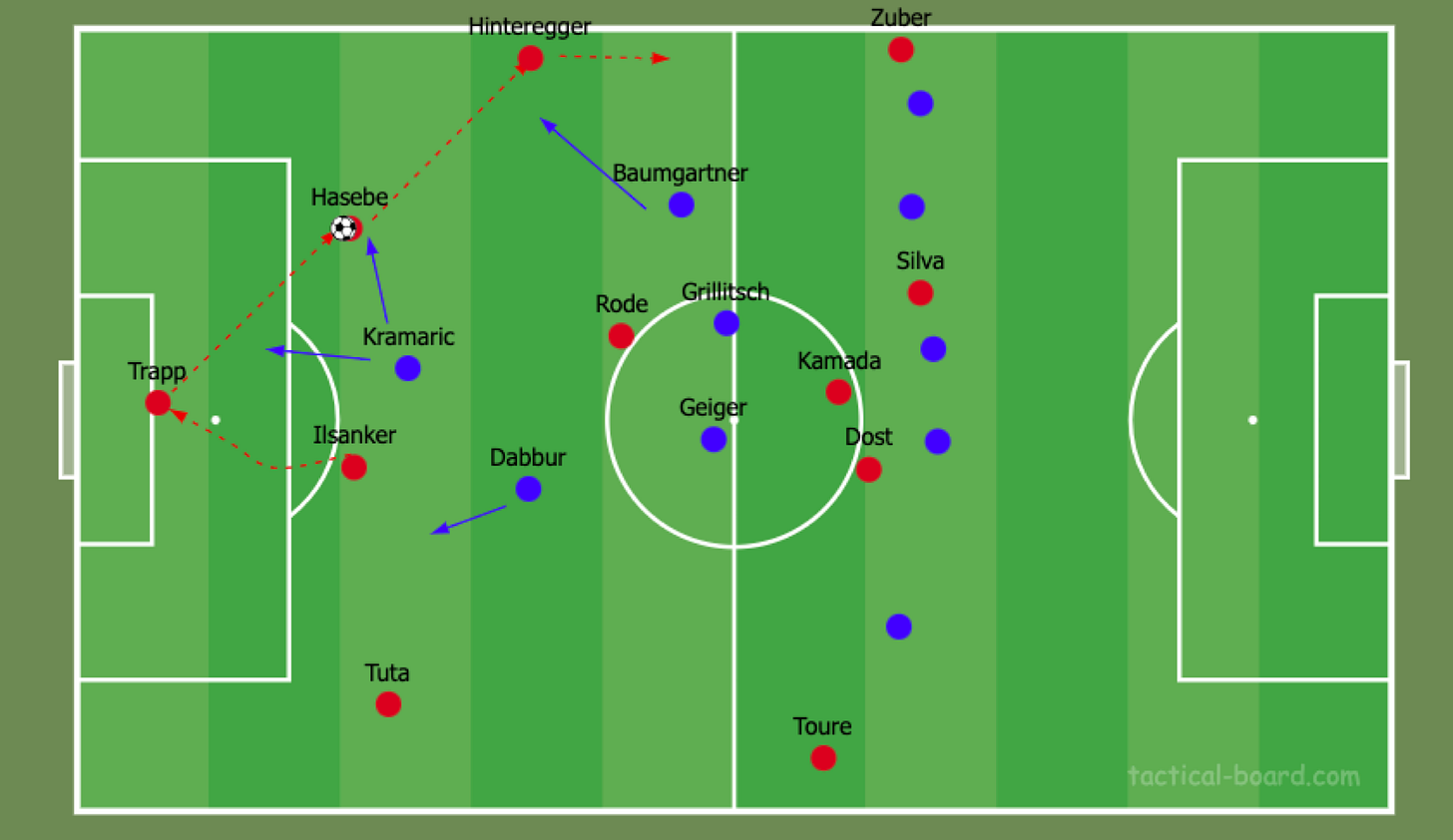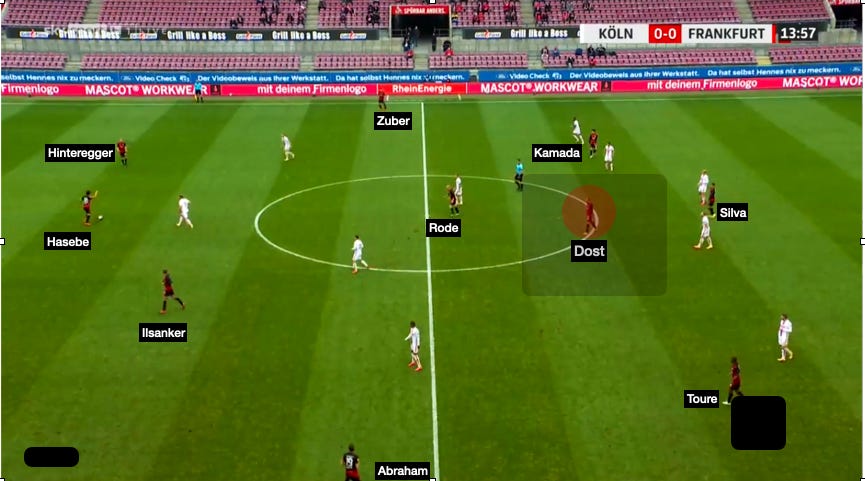Part 2 of the rise of Eintracht Frankfurt : early season success followed by Bayern reality check
Dost, Ilsanker, Kamada, Barkok and the 2 striker system's limitations
I'm not better than the next trader, just quicker at admitting my mistakes and moving on to the next opportunity. - George Soros
Despite missing Andre Silva due to injury, Eintracht Frankfurt pulled off a major upset over Bayern Munich on Matchday 22. Their 2-1 victory saw SGE press and harangue Bayern in the first half, with Amin Younes, Filip Kostic and Daichi Kamada running riot over the Bavarians, whose second half Leon Goretzka led comeback ultimately fell short. The win now made it 11 unbeaten and 9 wins out of 10 for Eintracht, who have never started a Rückrunde with 5 consecutive wins.
Their chances of finishing in the UCL places have climbed to 64% over at Fivethirtyeight, compared to 18% on January 20th!
In order to fully appreciate this current Frankfurt team’s achievements, it’s worth looking back at where they came from. Part one looked at Eintracht’s transition season from the Büffelherde to missing out on Europe in 19\20 while this next part seeks to establish the context of Eintracht Frankfurt’s early start and then discuss their post-Bayern match struggles before the improbable success in 2021.
In going through the first 5 games, this piece will examine the (lack of) offseason moves, Adi Hütter’s 3412 system and its difficulties with regards to Bas Dost, their midfield issues in defensive transition and how the road to redemption began.
As always, these are my observations based on various input: personal experience/text/audio/video and data which I’ve accumulated over the last couple of years.
“Historic season” with 2 wins 8 draws and 2 losses from first 12 matches
But how did this happen? It was from a steady climb to the top…. After all, most experts and betting sites had Eintracht between 7th (Tobias Escher was the highest on them) and 10th place. That all seemed quite realistic given the club’s situation, where Eintracht were still consolidating after their outlier season triggered the sale of Haller/Jovic/Rebic, while those with stronger squads and better resources were aiming higher.



There was no reason to think SGE could challenge last season’s top 5, despite Leverkusen and Leipzig getting weaker. If anything the challenge would seemingly come from the likes of the suddenly well-off Hertha, Seba Hoeness’ Hoffenheim or perhaps the steady improvement of Oliver Glasner’s Wolfsburg. In comparison, Eintracht were just not that exciting, and it did not only make sense narratively, but also squad depth-wise.
Much like the rest of the Bundesliga, impacted by COVID, Bobic and co were always unlikely to be able to to spend much on the transfer market. Now that Eintracht were no longer in Europe, their main concern was to thin the squad: Marco Russ, Johnny de Guzman and Gelson Fernandes all retired, while letting go of the likes of Simon Falette, Lucas Torro, Felix Wiedwald didn’t raise too many eyebrows. Loaning the young players such as Joveljic, Zalazar was smart, but not as smart as getting 2m from a desperate Schalke for Paciencia, which was the cost of the Amin Younes loan from Napoli. (more on that later)
They also swapped backup GKs with the Royal Blues (Fredrik Rönnow for Markus Schubert) and Hoffenheim. The latter move, Steven Zuber for Mijat Gacinovic now seems like a lose-lose for everyone in hindsight, even if Zuber got a few chances to play early in the season following Kostic’s injury. Finally they added two little-known players from the Eredivisie, the pacy but injury prone striker Ragnar Ache and the winger/playmaker Ajdin Hrustic (former Schalke teammate of Leroy Sané at the U17 level) neither of whom lit the Dutch league on fire at ages 22-24 respectively. It was certainly a very budget conscious approach and understandably not much to get excited about.
Early success via the 2 striker system
What fans of die Adler could get excited about were the first 3 games of the season. It all went quite well from Eintracht - the unfortunate opening day draw and the subsequent loss of Kostic on MD2 notwithstanding -as they took a 3 goal lead vs Hertha thanks to the Bas Dostiest header and Seppi Rode’s wonderful goal and hung on for the 3-1 win despite Hinteregger’s own goal. It was followed by an even first half, where they went behind after an outrageous Kramaric chip, before blowing away Hoffenheim in the 2nd half. Although some of it was thanks to the higher positioned wingbacks having better counterpressing access and some considerable difficulties for Hoffenheim to defend defensive transitions (Akpoguma), we must acknowledge Kamada’s improvement and his amazing solo before the 2-1. The 24-year-old Japanese has long been a Hütter project, ever-improving defensively, physically and in terms of effectiveness (both in terms of keeping the ball and finishing), but always possessed wonderful ability to unlock defenses via runs and passes. He was the standout player early on in the season, but it’s worth looking at Eintracht’s footballing ideas in a 3142 shape, which had 2 set patterns:
building a back 4 by dropping one of the DMs (Rode and Ilsanker were the starters at this point) and getting out against the high press via their very wide CBs with the high wingbacks and usually at least Silva and Bas Dost pinning the opposition’s back line deep.
Given that the Red Bull inspired Adi Hütter is their coach, it’s no surprise that Eintracht don’t have elaborate buildup patterns, they just want to get the ball to Dost and do layoffs to progress or at least get into good counterpressing shape once in the final 3rd

Certainly in the early portion of the season, they had some key actors atop the pressing rankings, although both Rode and Kamada are surprises on here.
Two strikers, Bas Dost being too deep, not enough presence between the lines,
However, that certainly did not mean Eintracht were firing on all cylinders:
Lacking the speed and dribbling of Kostic, Hütter had Zuber play as a right footed LWB, providing an interesting diagonal option, but not a lot of end product, so a lot of the creativity fell on Daichi Kamada in the halfspaces, with the Japanese preferring the left side.
The other main issue was Bas Dost, who dropped incredibly deep to collect the ball, which is not great in theory (why do you wanna have your target man at midfield, especially when he no longer has the legs to get to the box) and only rarely good in practice (transition, so he can lay off to runners).
In addition, the injury to Evan Ndicka robbed Eintracht of their most athletic CB and pushed Hinteregger to LCB, where he’s both less effective and seems to have deferred to Hasebe. As we see above, against a 532 with man orientations, Hasebe often had to dribble forward -something he’s great at even at 37 - but Dost was often so deep that he could be picked up by the DM and not pull the CB out and the Japanese wasn’t always given options to pass to.
Although Hinteregger could hit Dost on these diagonals, a lot of the playmaking
fell to Hasebe, who also managed to access the Dutchman who to his credit did have 2 goals and 2 assists in the 3 game spell.
While, it’s probably not Bas Dost you want making plays between the lines, though until the Bayern match, Frankfurt were still doing great. With 8 points from 4 games, with an xG of 8 for vs 3.7 against, and 24.25 shot creating actions, a figure that would still have them as the 2nd most productive offensive alongside RBL, BVB and Stuttgart - all stats per Fbref.com - Eintracht was off to a flying start.
Unfortunately, the 5-0 defeat against Bayern was just too easy, in particular the double six of Rode and Ilsanker (several times failing to make tactical fouls, or going in to challenge) looked sluggish and unathletic against Kimmich, Steven Zuber didn’t put in a good performance and Leroy Sané ran riot.
Aside from the goals, one way to measure this ease of the Bayern demolition and account for SGE’s struggles is to examine pressure locations and success. This season, on a per 90 basis, Eintracht average around 153 events, which in line with the general trend in a congested European schedule is down from their 173.8 last season. That 153 is still the 7th most in the big 5 leagues, but more importantly Frankfurt have a success rate of 49% only bettered by two of Europe’s pressing juggernauts in Glasner’s Wolfsburg at 50% and Bielsa’s Leeds at 52%. Unfortunately that success rate vs Bayern that mark was just 28%, and you could visibly see the lack of range in midfield. In particular, Stefan Ilsanker - previously a standout player in the RB system due to his intelligence, versatility, leadership and once known as a counterpressing machine — looked off his best, which is borne out by Fbref data: he is pressing more than before, but perhaps due to his diminishing athleticism and range less successful in pressures (just 28% vs 35% as his worst season) and tackling (27% is the lowest since his last Leipzig season, which perhaps offers a reason why RBL were okay with letting him leave on a free).
A 5-0 pummeling at the hands of Bayern is often something best described by former Werder player Sebastian Prödl, who won Germany’s “football saying of the year” in 2015 for the infamous words: "Munich is like a visit to the dentist. Everyone has to go there. Can be quite painful. But it can also end lightly. (fortunately)"
While it’s tough to take positives out of that match, perhaps the light at the end of that tunnel was Hütter being able to try a couple of his offensive weapons, who were once considered promising youngsters now looking for a second chance:
local born Aymen Barkok has been in the Eintracht youth setup since 2013 and was a regular for Germany at the youth level, before declaring for Morocco recently. At the club level, the talented winger failed to break through under Kovac and spent the past 2 seasons at Fortuna Düsseldorf.
Amin Younes was in Gladbach’s youth teams since age 8 and made his debut at age 19 under Lucien Favre. Undergoing a remarkable footballing education under coaches such as Horst Hrubesch (DFB youth teams) Jogi Löw (called him up to the Confed Cup), Peter Bosz and Erik ten Hag (Ajax), Gennaro Gattuso and Carlo Ancelotti (Napoli), his career so far was more about not always living up to his limitless potential.
The next part analyzes some successful and some not so beneficial tactical adjustments as well as some personnel changes that at first solidified Frankfurt as rock solid Bundesliga team. It also discusses the growing importance of Aymen Barkok, why the double 10 was not yet an option, as well as offer some observations on the reasons for their winless spell following a good start. Finally, it will lay the groundwork how Andre Silva, Amin Younes, Fredi Bobic and Adi Hütter managed to turn Frankfurt into the best Bundesliga team of 2021. ,
Thanks for reading!










Phew, epic series of posts! Learned a lot about Eintracht.
On the topic of Hasebe's dribbling exploits: found this highlight pack from his days as a dribbly #8/#10 player back in Japan. He just has to line up as a striker once before he retires, since he got the keeper cameo out of the way at Wolfsburg.
https://www.youtube.com/watch?v=9FTwNlxnMqs